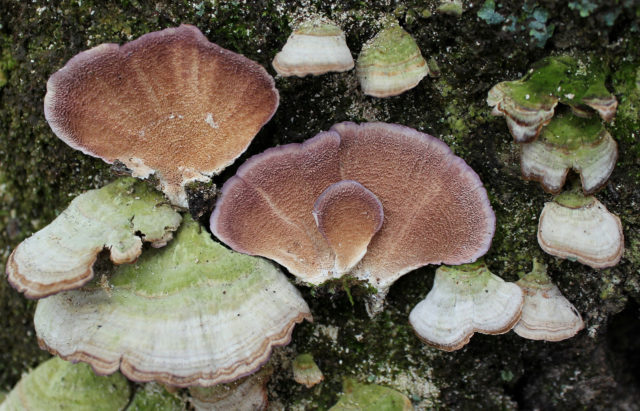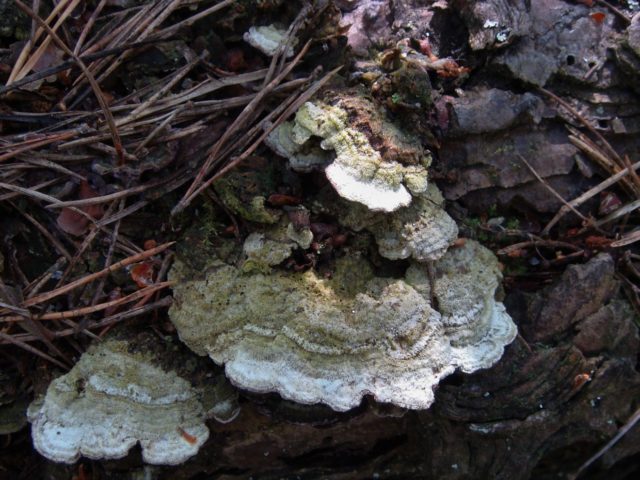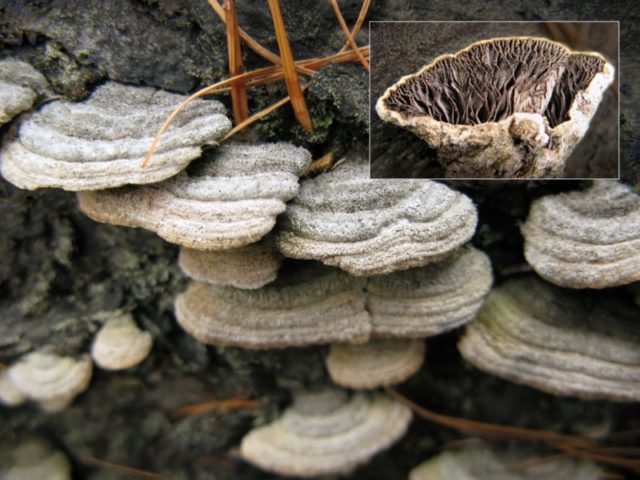Content
Trichaptum biforme is a mushroom from the Polyporovye family, belonging to the Trichaptum genus. It is considered a widespread species. Grows on fallen deciduous trees and stumps. Causes the appearance of white rot, which accelerates the process of destruction of wood.
What a trichaptum looks like is twofold
The mushroom consists of numerous caps forming a semicircular tiled group. The diameter of the cap is up to 6 cm, the thickness is up to 3 mm. In young specimens, the surface is pubescent, reminiscent of felt, over time it becomes smooth, silky. The color of the cap can be brownish-green, ocher, light gray. In some representatives, the outer edge has a light purple color. If the weather is dry, sunny, the surface fades, becoming whitish.

Concentric banding is visible on the cap
In fruit bodies, the color of the hymenophore is purple-violet. An increase in hue is observed at the edges. If damaged, the color does not change. In older specimens, the lower part of the cap fades, becoming brownish yellow or brown.
The mushroom has no leg.
The inner part is hard, painted in a light, almost white shade.
The color of the spore powder is white.
Where and how it grows
This representative of the mushroom kingdom belongs to the saprotrophs, therefore it grows on dead wood and stumps. Prefers deciduous trees. Most often, the double trichaptum chooses birch, but it can also be found on alder, aspen, hornbeam, beech, oak. It practically does not grow on conifers.
The distribution area of mushrooms is very wide. In Russia, they are found everywhere: from the European part to the Far East. They prefer a temperate climate; they grow very rarely in the tropics.
The appearance of trichaptum twofold is accompanied by white rot on the wood. This leads to its rapid destruction.
Fruiting from July to October.
Is the mushroom edible or not
Trichaptum is classified in two ways as inedible specimens. Its pulp is too tough, has no nutritional value, so mushroom families are not harvested and used for cooking.
Doubles and their differences
Trichaptum twofold has several similar varieties. It is very easy to confuse them if you do not know some of the features of growth and structure. Doubles can be called:
- Trichaptum spruce - a smaller representative of the mushroom kingdom, growing in rows or groups on conifers. The hats of this subspecies are monophonic, gray in color. The pubescence on them is more noticeable than in the double representative. The purple color of the hymenophore is well expressed and persists for a long time.
- Brown-violet varietyb (Trichaptum fuscoviolaceum) also resembles a twofold species.Important! The main difference is the place of growth.
This species is found only on conifers. It can be recognized by the hymenophore, formed in the form of radially diverging teeth, which at the edges are transformed into serrated plates.
- Larch subspecies has a slight pubescence and a light gray, whitish color of the cap. Found in coniferous forests, prefers larch. It can also be found on other conifers. The hymenophore is formed from wide plates. Due to the rigidity of the fruiting body, it is unsuitable for use in food.Attention! Classified as inedible.
Conclusion
Trichaptum is twofold - an inedible representative of the mushroom kingdom, widespread everywhere. Selects felled trees and hardwood stumps for growth. It has several inedible twins, differing in habitat and external features. The fungus provokes the appearance of white rot, which destroys wood.











